
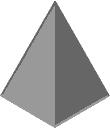
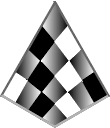
Martian Chess is an Icehouse game. That is, it is a game played with the pyramidal pieces sold as Icehouse: The Martian Chess Set by Looney Laboratories. Typically, the game is played by four people on a full chessboard, or by two people on a half-chessboard. In the game, each player controls a "zone" of 16 squares. The pieces within a player's zone are controlled by that player. Pieces that leave the zone fall under the control of the player who controls the zone where the piece winds up. On a standard chessboard, these zones are four by four squares of 16 squares each.
So, Martian Chess is a good game if you have one friend available, or if you have three friends available, but what if you only have two friends available? You could act as if the fourth zone was a space warp, like in Wiz-War, but it's very hard to visualize the actual topology of the board if you do it that way. What you need is a special chessboard, morphed to contain three zones and be triangular.
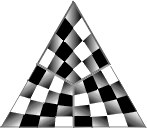
The special three-player Martian Chess board can be thought of as being three sides of a cube, flattened into two dimensions, and then stretched into a triangular shape. If you think in terms of three dimensions, you won't be so confused at what you're seeing when the pieces move on the two-dimensional board.
By adding gradient fills to the traditional black & white of a standard chessboard, I've made it possible to use the same shape for each third of the board.

If you don't want to construct the board yourself, you'll need to download and print out either the Portable Document Format (94 K) version of my design. Print it out three times, so that you have enough pieces. Then, trim off the extra paper and arrange the three pieces into a triangle as shown above (the points with the 120 degree angle go in the middle). If you want, you can laminate the pieces, and/or mount them on a thicker backing.
Mostly, you can just play as specified in the rules of Martian Chess. Note that the topology of the board is a little weird. You might find some of the possible moves to be a little surprising.
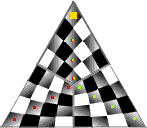
The very center of the board is sort of a singularity. Any move that passes your piece through the very center of the board forces you to choose between the two possible zones.
For instance, the Yellow Queen at the top of the diagram, once she reaches the center, must choose between following the red path, or following the green path.

On a regular Chessboard, two paths will either be parallel or perpendicular. On the triangular board, since crossing a canal introduces a 60 degree change of direction, two paths can start out parallel, but wind up crossing.
If you view any two adjacent zones as being chessboard quadrants, you can see that individually the paths are straight. Remember what I said earlier about visualizing?

Another topological oddity is that an orthogonal path and a diagonal path can intersect at two points on the board. This means that Queens, with their long range, can sometimes have two separate attack paths to the same square.
If this is too confusing, you can simplify things by saying that a piece is only allowed to cross one canal in a single turn.
You can also use this board to play three player Martian Go. "Martian Go is an elegant little strategy game for two or four players. It is a turn-based game, [...] and there is no luck involved." Simply place root tokens on the three central spaces of the triangular board, and go from there.

Zarf also points out that if you print out six pieces, and assemble them around the sharpest point, you will construct a hexagonal board on which six people can play Martian Chess or Martian go. He comments that "a queen moving along a (radial) diagonal must continue straight across, [and] a pawn moving diagonally from one of the center spaces [should] do the same."
He also comments that a six-player game of Martian Go, "would get painful."
There are enough pieces in a four-player set to furnish pieces for a six-player game of Martian Chess.
If six-player games turn out to be too painful, you can just break the game up into three two-player games.
Take two pieces, and push the together so that two sides of equal length are touching. You can construct four different shapes of two-player boards this way. Playing on these boards is topologically identical to playing on half a 'normal' chess board, it just looks a little funny.

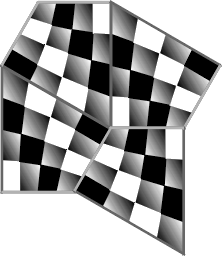
In fact, you can use four pieces to contruct a "normal" four-player board. You can play four player games on these boards, but expect to get stares if you do so in public.
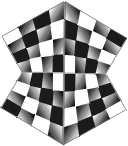
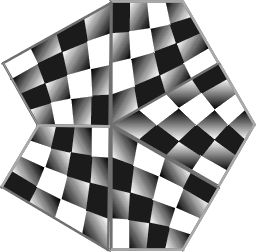
Since six over two, plus four over two, equals five, you can construct a five-player board by using half a six-player board and half a four-player board. For this board, the players on either side of you can be considered to be positioned orthogonally from you, and the two players across from you can both be considered to be positioned diagonally from you.
 [You can now purchase a durable plastic version of these boards!]
[You can now purchase a durable plastic version of these boards!]